Use of Plant Proteins as Microencapsulating Agents of Bioactive Compounds Extracted from Annatto Seeds (Bixa orellana L.)
Abstract
1. Introduction
2. Materials and Methods
2.1. Materials
2.2. Annatto Seed Extract
2.2.1. Total Polyphenol Compounds
2.2.2. Quantification of Bixin
2.2.3. Ferric Reducing Antioxidant Power (FRAP)
2.2.4. Superoxide Radical Scavenging Activity (SRSA)
2.2.5. Antimicrobial Activity of Annatto Seed Extracts
2.3. Extraction of Proteins from Quinoa and Lentils
2.4. Preliminary Encapsulation Studies
2.5. Encapsulation of Annatto Extract
2.5.1. Encapsulation Efficiency
2.5.2. Confocal Microscopy and Scanning Electron Microscopy (SEM)
2.5.3. Particle Size Measurements
2.5.4. Infrared Transmission Spectroscopy
2.6. Statistical Analysis
3. Results
3.1. Encapsulation of Annatto Extract using Plant Proteins as a Wall Material
3.2. Stability Studies of the Encapsulated Annatto Seed Extract
3.3. Antioxidant and Antimicrobial Activities of the Encapsulated Annatto Extract
4. Discussion
5. Conclusions
Author Contributions
Funding
Conflicts of Interest
References
- Viuda, M.; Ciro, G.L.; Ruiz, Y.; Zapata, J.E.; Sendra, E.; Pérez-Álvarez, J.A.; Fernández-López, J. In vitro Antioxidant and Antibacterial Activities of Extracts from Annatto (Bixa orellana L.) Leaves and Seeds. J. Food Saf. 2012, 32, 399–406. [Google Scholar] [CrossRef]
- Zhang, H.; Xue, L.; Li, B.; Tian, H.; Zhang, Z.; Tao, S. Therapeutic potential of bixin in PM2.5 particles-induced lung injury in an Nrf2-dependent manner. Free Radic. Biol. Med. 2018, 126, 166–176. [Google Scholar] [CrossRef] [PubMed]
- Quintero Quiroz, J.; Naranjo Duran, A.M.; Silva Garcia, M.; Ciro Gomez, G.L.; Rojas Camargo, J.J. Ultrasound-Assisted Extraction of Bioactive Compounds from Annatto Seeds, Evaluation of Their Antimicrobial and Antioxidant Activity, and Identification of Main Compounds by LC/ESI-MS Analysis. Int. J. Food Sci. 2019, 2019, 3721828. [Google Scholar] [CrossRef] [PubMed]
- Campos, R.; Yamashita, F.; Cesar, F.; Zerlotti, A. Simultaneous extraction and analysis by high performance liquid chromatography coupled to diode array and mass spectrometric detectors of bixin and phenolic compounds from annatto seeds. J. Chromatogr. A 2011, 1218, 57–63. [Google Scholar] [CrossRef]
- Butnariu, M. Methods of Analysis (Extraction, Separation, Identification and Quantification) of Carotenoids from Natural Products. J. Ecosyst. Ecography 2016, 6, 1–19. [Google Scholar] [CrossRef]
- Shahid-ul-Islam; Rather, L.J.; Mohammad, F. Phytochemistry, biological activities and potential of annatto in natural colorant production for industrial applications—A review. J. Adv. Res. 2016, 7, 499–514. [Google Scholar] [CrossRef]
- Ozkan, G.; Franco, P.; De Marco, I.; Xiao, J.; Capanoglu, E. A review of microencapsulation methods for food antioxidants: Principles, advantages, drawbacks and applications. Food Chem. 2019, 272, 494–506. [Google Scholar] [CrossRef]
- Kurozawa, L.E.; Hubinger, M.D. Hydrophilic food compounds encapsulation by ionic gelation. Curr. Opin. Food Sci. 2017, 15, 50–55. [Google Scholar] [CrossRef]
- Lupo, B.; Maestro, A.; Gutiérrez, J.M.; González, C. Characterization of alginate beads with encapsulated cocoa extract to prepare functional food: Comparison of two gelation mechanisms. Food Hydrocoll. 2015, 49, 25–34. [Google Scholar] [CrossRef]
- Nikoo, A.M.; Kadkhodaee, R.; Ghorani, B.; Razzaq, H.; Tucker, N. Electrospray-assisted encapsulation of caffeine in alginate microhydrogels. Int. J. Biol. Macromol. 2018, 116, 208–216. [Google Scholar] [CrossRef]
- Xu, Y.; Hanna, M.A. Electrospray encapsulation of water-soluble protein with polylactide: Effects of formulations on morphology, encapsulation efficiency and release profile of particles. Int. J. Pharm. 2006, 320, 30–36. [Google Scholar] [CrossRef]
- Abaee, A.; Mohammadian, M.; Mahdi, S. Trends in Food Science & Technology Whey and soy protein-based hydrogels and nano-hydrogels as bioactive delivery systems. Trends Food Sci. Technol. 2017, 70, 69–81. [Google Scholar] [CrossRef]
- Ben-Harb, S.; Panouillé, M.; Huc-Mathis, D.; Moulin, G.; Saint-Eve, A.; Irlinger, F.; Bonnarme, P.; Michon, C.; Souchon, I. The rheological and microstructural properties of pea, milk, mixed pea/milk gels and gelled emulsions designed by thermal, acid, and enzyme treatments. Food Hydrocoll. 2018, 77, 75–84. [Google Scholar] [CrossRef]
- Pimentel, D.; Pimentel, M. Sustainability of meat-based and plant-based diets and the environment. Am. J. Clin. Nutr. 2003, 78, 660–663. [Google Scholar] [CrossRef] [PubMed]
- Boland, M.J.; Rae, A.N.; Vereijken, J.M.; Meuwissen, M.P.M.; Fischer, A.R.H.; van Boekel, M.A.J.S.; Rutherfurd, S.M.; Gruppen, H.; Moughan, P.J.; Hendriks, W.H. The future supply of animal-derived protein for human consumption. Trends Food Sci. Technol. 2013, 29, 62–73. [Google Scholar] [CrossRef]
- Avramenko, N.A.; Chang, C.; Low, N.H.; Nickerson, M.T. Encapsulation of flaxseed oil within native and modified lentil protein-based microcapsules. Food Res. Int. 2016, 81, 17–24. [Google Scholar] [CrossRef]
- Tang, C.H.; Li, X.R. Microencapsulation properties of soy protein isolate and storage stability of the correspondingly spray-dried emulsions. Food Res. Int. 2013, 52, 419–428. [Google Scholar] [CrossRef]
- Jun-xia, X.; Hai-yan, Y.; Jian, Y. Microencapsulation of sweet orange oil by complex coacervation with soybean protein isolate/gum Arabic. Food Chem. 2011, 125, 1267–1272. [Google Scholar] [CrossRef]
- Nesterenko, A.; Alric, I.; Silvestre, F.; Durrieu, V. Vegetable proteins in microencapsulation: A review of recent interventions and their effectiveness. Ind. Crops Prod. 2013, 42, 469–479. [Google Scholar] [CrossRef]
- Nesterenko, A.; Alric, I.; Violleau, F.; Silvestre, F.; Durrieu, V. The effect of vegetable protein modifications on the microencapsulation process. Food Hydrocoll. 2014, 41, 95–102. [Google Scholar] [CrossRef]
- Liu, F.; Chen, Z.; Tang, C.H. Microencapsulation properties of protein isolates from three selected Phaseolus legumes in comparison with soy protein isolate. LWT-Food Sci. Technol. 2014, 55, 74–82. [Google Scholar] [CrossRef]
- Nesterenko, A. Etude et Fonctionnalisation de Protéines Végétales en vue de leur Application en Microencapsulation. Ph.D. Thesis, University of Toulouse, Toulouse, France, 2012. [Google Scholar]
- Zhang, Y.; Zhong, Q. Encapsulation of bixin in sodium caseinate to deliver the colorant in transparent dispersions. Food Hydrocoll. 2013, 33, 1–9. [Google Scholar] [CrossRef]
- Schmidt, V.; Giacomelli, C.; Soldi, V. Thermal stability of films formed by soy protein isolate-sodium dodecyl sulfate. Polym. Degrad. Stab. 2005, 87, 25–31. [Google Scholar] [CrossRef]
- Robert, P.; Gorena, T.; Romero, N.; Sepulveda, E.; Chavez, J.; Saenz, C. Encapsulation of polyphenols and anthocyanins from pomegranate (Punica granatum) by spray drying. Int. J. Food Sci. Technol. 2010, 45, 1386–1394. [Google Scholar] [CrossRef]
- Moreno, T.; Cocero, M.J.; Rodríguez-Rojo, S. Storage stability and simulated gastrointestinal release of spray dried grape marc phenolics. Food Bioprod. Process. 2018, 112, 96–107. [Google Scholar] [CrossRef]
- Kharlamova, A.; Nicolai, T.; Chassenieux, C. Calcium-induced gelation of whey protein aggregates: Kinetics, structure and rheological properties. Food Hydrocoll. 2018, 79, 145–157. [Google Scholar] [CrossRef]
- Banerjee, S.; Chattopadhyay, P.; Ghosh, A.; Goyary, D.; Karmakar, S.; Veer, V. Influence of process variables on essential oil microcapsule properties by carbohydrate polymer-protein blends. Carbohydr. Polym. 2013, 93, 691–697. [Google Scholar] [CrossRef]
- Chen, W.; Ma, X.; Wang, W.; Lv, R.; Guo, M.; Ding, T.; Ye, X.; Miao, S.; Liu, D. Preparation of modified whey protein isolate with gum acacia by ultrasound maillard reaction. Food Hydrocoll. 2019, 95, 298–307. [Google Scholar] [CrossRef]
- Voli, M.; Paji, I.; Djordjevi, V.; Kne, Z.; Pe, I.; Stevanovi, Z.; Hadnadjev, M.; Bugarski, B. Alginate/soy protein system for essential oil encapsulation with intestinal delivery. Carbohydr. Polym. 2018, 200, 15–24. [Google Scholar] [CrossRef]
- Ceyhun Sezgin, A.; Sanlier, N. A new generation plant for the conventional cuisine: Quinoa (Chenopodium quinoa Willd.). Trends Food Sci. Technol. 2019, 86, 51–58. [Google Scholar] [CrossRef]
- Majeed, T.; Wani, I.A.; Hussain, P.R. Effect of dual modification of sonication and γ-irradiation on physicochemical and functional properties of lentil (Lens culinaris L.) starch. Int. J. Biol. Macromol. 2017, 101, 358–365. [Google Scholar] [CrossRef]
- Lafarga, T.; Álvarez, C.; Bobo, G.; Aguiló-Aguayo, I. Characterization of functional properties of proteins from Ganxet beans (Phaseolus vulgaris L. var. Ganxet) isolated using an ultrasound-assisted methodology. LWT-Food Sci. Technol. 2018, 98, 106–112. [Google Scholar] [CrossRef]
- Yang, Y.; He, Q.; Sun, H.; Cao, X.; Elfalleh, W.; Wu, Z.; Zhao, J.; Sun, X.; Zhang, Y.; He, S. PEGylation may reduce allergenicity and improve gelling properties of protein isolate from black kidney bean (Phaseolus vulgaris L.). Food Biosci. 2018, 25, 83–90. [Google Scholar] [CrossRef]
- Naranjo, A.M.; Quiroz, J.Q.; Gómez, G.C.; Comisión Nacional Asesora en Investigaciones de Plantas Medicinales. Revista Cubana de Plantas Medicinales; Editorial Ciencias Médicas: La Habana, Cuba, 1996; Volume 22. [Google Scholar]
- Swain, T.; Hillis, W.E. The phenolic constituents of Prunus domestica. I.—The quantitative analysis of phenolic constituents. J. Sci. Food Agric. 1959, 10, 63–68. [Google Scholar] [CrossRef]
- Quiroz, J.Q.; Torres, A.C.; Ramirez, L.M.; Garcia, M.S.; Gomez, G.C.; Rojas, J. Optimization of the Microwave-Assisted Extraction Process of Bioactive Compounds from Annatto Seeds (Bixa orellana L.). Antioxidants 2019, 8, 37. [Google Scholar] [CrossRef]
- Benzie, I.F.F.; Strain, J. The Ferric Reducing Ability of Plasma (FRAP) as a Measure of “Antioxidant Power”: The FRAP Assay. Anal. Biochem. 1996, 239, 70–76. [Google Scholar] [CrossRef]
- Alam, M.N.; Bristi, N.J.; Rafiquzzaman, M. Review on in vivo and in vitro methods evaluation of antioxidant activity. Saudi Pharm. J. 2013, 21, 143–152. [Google Scholar] [CrossRef]
- Quintero, J.; Celis, T.A.; Torres, J.D.; Ciro, G.; Corrrales, L.L.; Rojas Camargo, J.J. Physicochemical properties and functional characteristics of ultrasound-assisted legume-protein isolates: A comparative study. Food Sci. Technol. 2020, in press. [Google Scholar]
- Quintero, J.; Torres, J.D.; Ciro, G.; Rojas Camargo, J.J. Effect of the concentration, pH, and Ca2+ ions on the rheological properties of isolate proteins from quinoa, lentil, and black bean. J. Food Sci. Technol. 2020, in press. [Google Scholar]
- Chan, E.-S. Preparation of Ca-alginate beads containing high oil content: Influence of process variables on encapsulation efficiency and bead properties. Carbohydr. Polym. 2011, 84, 1267–1275. [Google Scholar] [CrossRef]
- Delgado, E.; Valverde-Quiroz, L.; Lopez, D.; Cooke, P.; Valles-Rosales, D.; Flores, N. Characterization of Soluble Glandless Cottonseed Meal Proteins Based on Electrophoresis, Functional Properties, and Microscopic Structure. J. Food Sci. 2019, 84, 2820–2830. [Google Scholar] [CrossRef]
- Hosseini, S.M.; Hosseini, H.; Mohammadifar, M.A.; Mortazavian, A.M.; Mohammadi, A.; Khosravi-Darani, K.; Shojaee-Aliabadi, S.; Dehghan, S.; Khaksar, R. Incorporation of essential oil in alginate microparticles by multiple emulsion/ionic gelation process. Int. J. Biol. Macromol. 2013, 62, 582–588. [Google Scholar] [CrossRef]
- Casanova, Y.H.F.; Cardona, S. Emulsions stabilized with sodium caseinate: Effect of calcium ions, protein concentration and temperature. Vitae 2004, 11, 13–19. [Google Scholar]
- Smith, G.A.; Friedman, M. Effect of Carbohydrates and Heat on the Amino Acid Composition and Chemically Available Lysine Content of Casein. J. Food Sci. 1984, 49, 817–820. [Google Scholar] [CrossRef]
- Nesterenko, A.; Alric, I.; Silvestre, F.; Durrieu, V. Comparative study of encapsulation of vitamins with native and modified soy protein. Food Hydrocoll. 2014, 38, 172–179. [Google Scholar] [CrossRef]
- Bhatty, R.S. Protein subunits and amino acid composition of wild lentil. Phytochemistry 1986, 25, 641–644. [Google Scholar] [CrossRef]
- Nowak, V.; Du, J.; Charrondière, U.R. Assessment of the nutritional composition of quinoa (Chenopodium quinoa Willd.). Food Chem. 2016, 193, 47–54. [Google Scholar] [CrossRef]
- Mäkinen, O.E.; Zannini, E.; Koehler, P.; Arendt, E.K. Heat-denaturation and aggregation of quinoa (Chenopodium quinoa) globulins as affected by the pH value. Food Chem. 2016, 196, 17–24. [Google Scholar] [CrossRef]
- Tang, C.H.; Ma, C.Y. Heat-induced modifications in the functional and structural properties of vicilin-rich protein isolate from kidney (Phaseolus vulgaris L.) bean. Food Chem. 2009, 115, 859–866. [Google Scholar] [CrossRef]
- Rahmalia, W.; Fabre, J.-F.; Mouloungui, Z. Effects of Cyclohexane/Acetone Ratio on Bixin Extraction Yield by Accelerated Solvent Extraction Method. Procedia Chem. 2015, 14, 455–464. [Google Scholar] [CrossRef]
- Chao, W.; Wang, J.; Yan, X.; Ma, W.; Wu, D.; Du, M. Effect of partial replacement of water-soluble cod proteins by soy proteins on the heat-induced aggregation and gelation properties of mixed protein systems. Food Hydrocoll. 2019, 100, 105417. [Google Scholar] [CrossRef]
- Kaspchak, E.; de Oliveira, M.A.S.; Simas, F.F.; Franco, C.R.C.; Silveira, J.L.M.; Mafra, M.R.; Igarashi-Mafra, L. Determination of heat-set gelation capacity of a quinoa protein isolate (Chenopodium quinoa) by dynamic oscillatory rheological analysis. Food Chem. 2017, 232, 263–271. [Google Scholar] [CrossRef]
- Mir, N.A.; Riar, C.S.; Singh, S. Structural modification of quinoa seed protein isolates (QPIs) by variable time sonification for improving its physicochemical and functional characteristics. Ultrason. Sonochem. 2019, 58, 104700. [Google Scholar] [CrossRef]
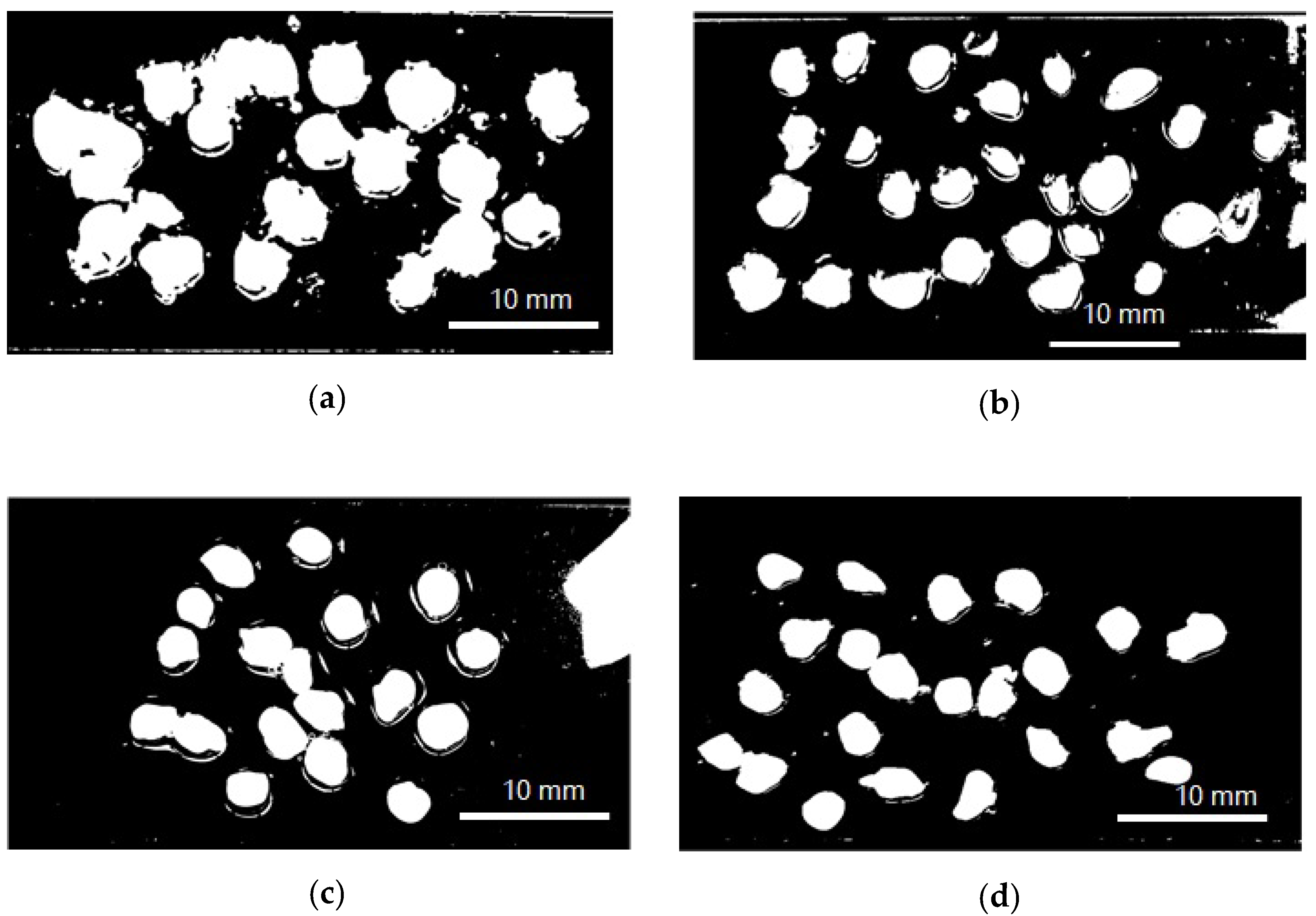
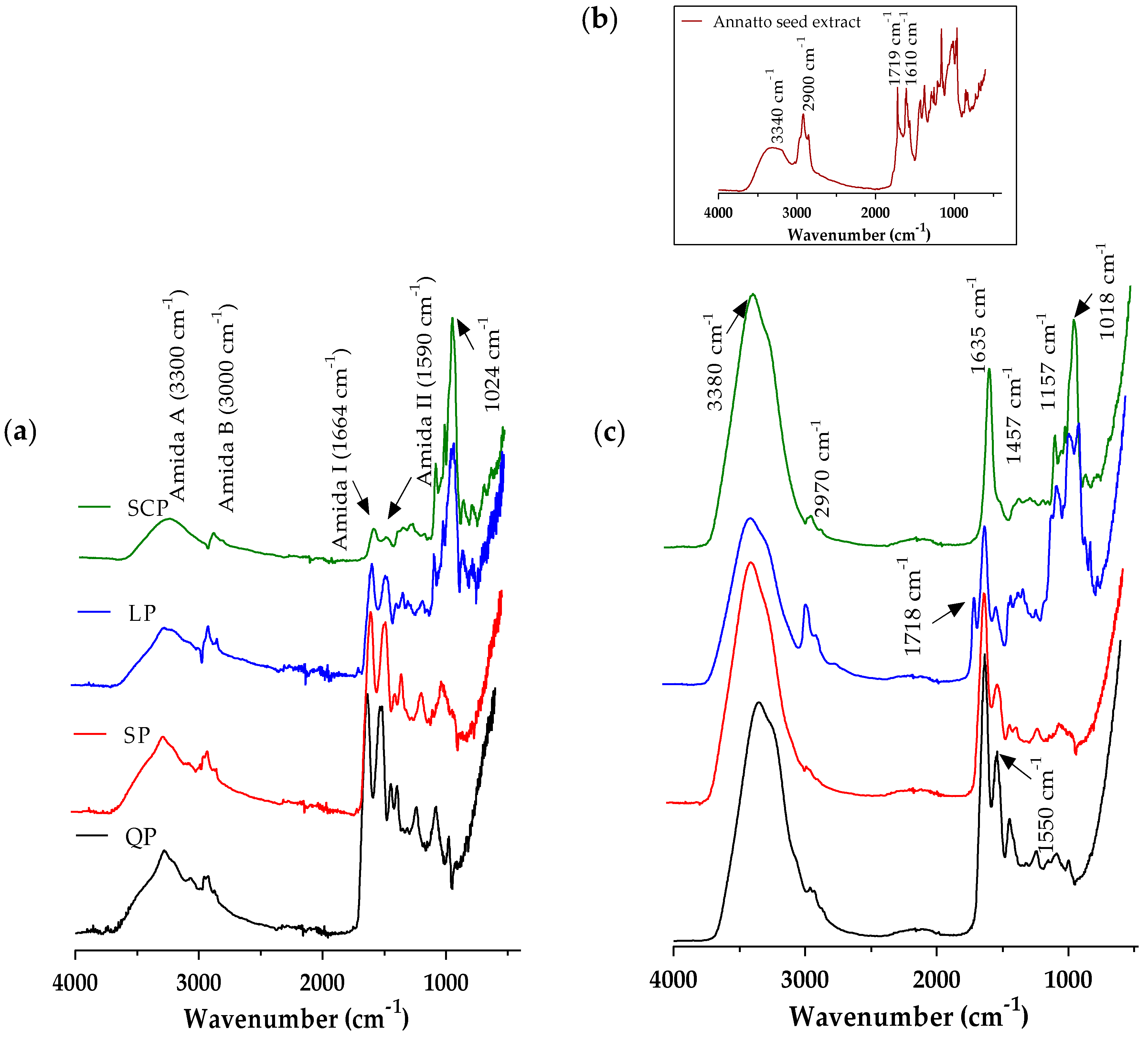
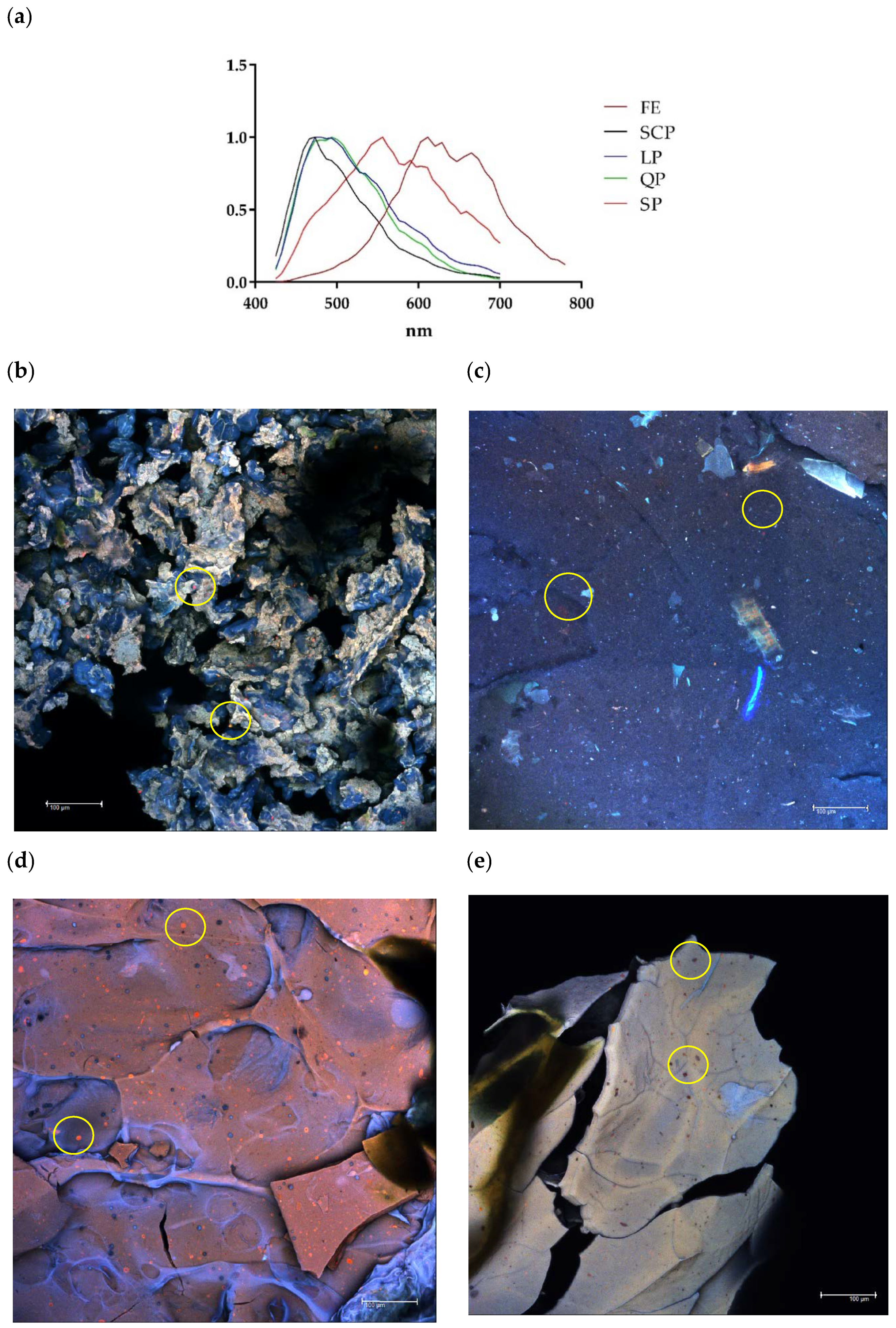
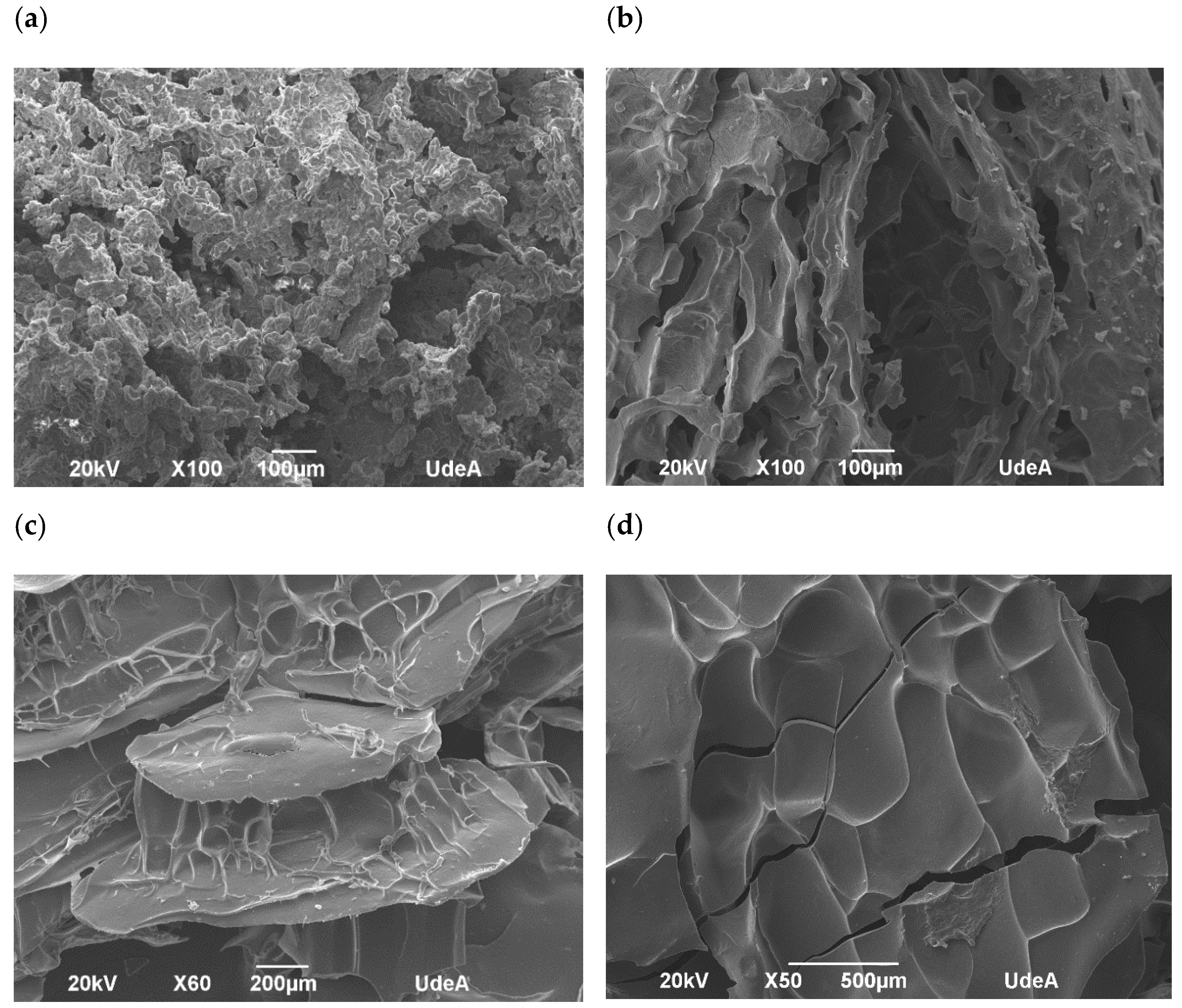
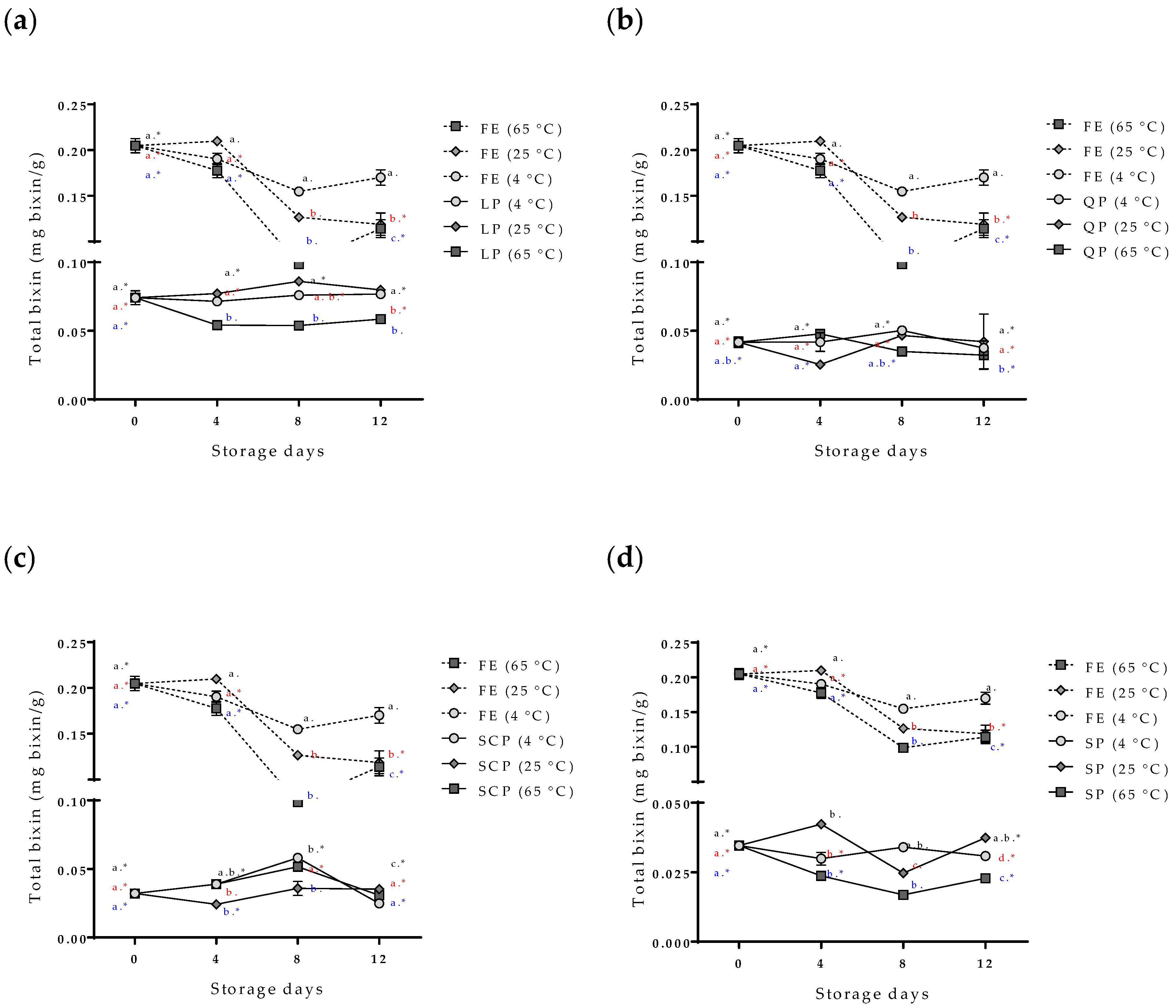
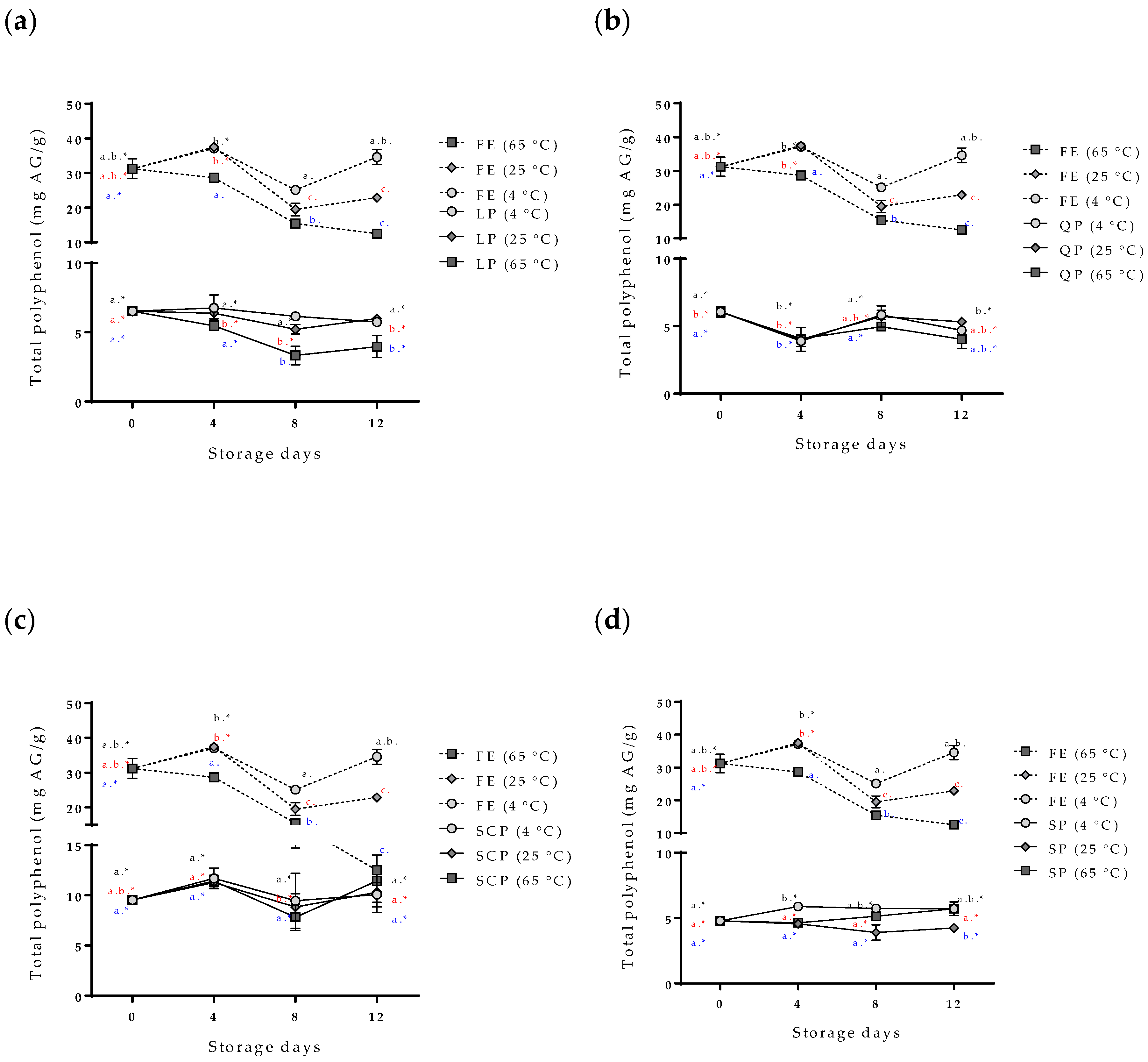
 , z-axis) and S. aureus (
, z-axis) and S. aureus ( , z-axis). FE: free extract, LP: lentil protein, QP: quinoa protein, SCP: sodium caseinate, SP: soy protein, D0: zero-day storage, D12: twelve-day storage.
, z-axis). FE: free extract, LP: lentil protein, QP: quinoa protein, SCP: sodium caseinate, SP: soy protein, D0: zero-day storage, D12: twelve-day storage.
 , z-axis) and S. aureus (
, z-axis) and S. aureus ( , z-axis). FE: free extract, LP: lentil protein, QP: quinoa protein, SCP: sodium caseinate, SP: soy protein, D0: zero-day storage, D12: twelve-day storage.
, z-axis). FE: free extract, LP: lentil protein, QP: quinoa protein, SCP: sodium caseinate, SP: soy protein, D0: zero-day storage, D12: twelve-day storage.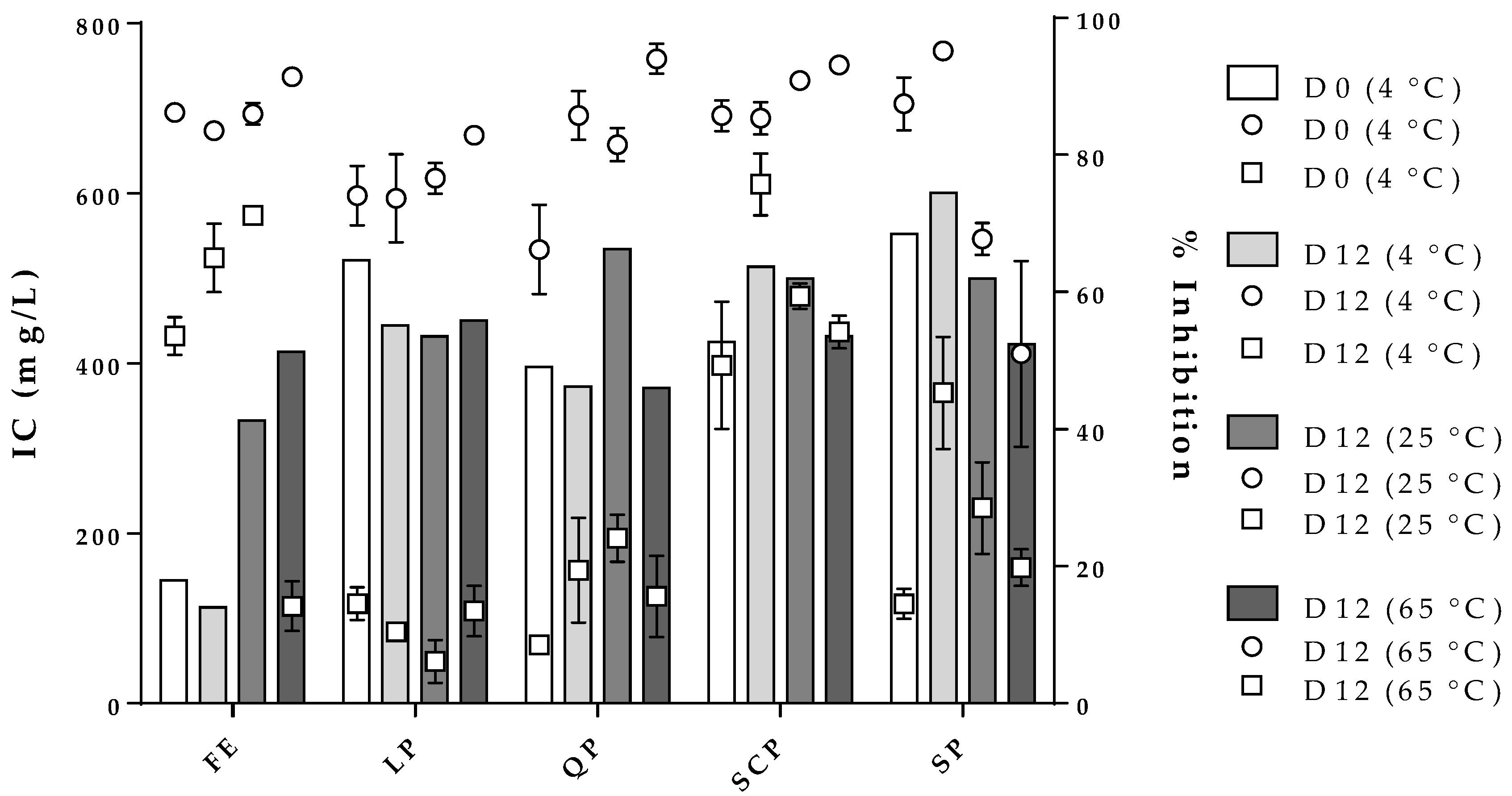
| Sample | LP | QP | SCP | SP | |
|---|---|---|---|---|---|
| EE (Bixin) | (%) | 68.61 ± 2.38 a | 58.38 ± 5.55 b | 79.36 ± 0.82 c | 71.88 ± 0.97 a |
| Particle size, in solution | mm | 4.00 ± 2.90 a,* | 4.08 ± 3.03 a | 3.67 ± 0.41 a | 3.52 ± 2.60 a |
| Particle, freeze-dried | mm | 2.08 ± 1.50 a,* | 2.00 ± 0.96 a | 2.61 ± 0.94 a | 2.84 ± 0.79 a |
| Antioxidant Activities (µmol Trolox/Kg) | Sample | ||||
|---|---|---|---|---|---|
| FE | LP | QP | SCP | SP | |
| FRAP D0 | 157.32 ± 3.61 a | 8.05 ± 0.30 a | 8.00 ± 0.20 a | 10.49 ± 0.43 a | 12.56 ± 0.37 a |
| FRAP D12 (4 °C) | 128.08 ± 14.07 b | 9.74 ± 1.11 a | 8.82 ± 3.94 a | 8.19 ± 0.24 a | 10.07 ± 2.12 a |
| FRAP D12 (25 °C) | 102.83 ± 11.57 b | 10.33 ± 0.47 a | 12.02 ± 3.12 a | 10.69 ± 2.56 a | 10.14 ± 1.81a |
| FRAP D12 (65 °C) | 73.52 ± 10.44 c | 5.64 ± 0.62 b | 8.67 ± 2.44 a | 9.94 ± 3.09 a | 12.08 ± 1.77 a |
| SRSA D0 | 13.27 ± 2.54 a | 2.78 ± 0.16 a | 3.77 ± 0.34 a | 3.87 ± 0.35 a | 3.29 ± 0.09 a |
| SRSA D12 (4 °C) | 12.38 ± 0.12 a | 2.80 ± 0.13 a,b | 2.58 ± 0.11 a,b | 3.42 ± 0.61 a | 3.98 ± 0.13 a |
| SRSA D12 (25 °C) | 8.24 ± 0.65 b | 4.12 ± 0.30 b,c | 4.38 ± 0.84 b,c | 4.02 ± 0.80 a | 3.37 ± 0.22 a |
| SRSA D12 (65 °C) | 5.94 ± 0.46 c | 3.17 ± 0.03 c | 2.39 ± 0.02 c | 3.85 ± 0.30 a | 4.52 ± 1.04 a |
© 2020 by the authors. Licensee MDPI, Basel, Switzerland. This article is an open access article distributed under the terms and conditions of the Creative Commons Attribution (CC BY) license (http://creativecommons.org/licenses/by/4.0/).
Share and Cite
Quintero Quiroz, J.; Velazquez, V.; Corrales-Garcia, L.L.; Torres, J.D.; Delgado, E.; Ciro, G.; Rojas, J. Use of Plant Proteins as Microencapsulating Agents of Bioactive Compounds Extracted from Annatto Seeds (Bixa orellana L.). Antioxidants 2020, 9, 310. https://doi.org/10.3390/antiox9040310
Quintero Quiroz J, Velazquez V, Corrales-Garcia LL, Torres JD, Delgado E, Ciro G, Rojas J. Use of Plant Proteins as Microencapsulating Agents of Bioactive Compounds Extracted from Annatto Seeds (Bixa orellana L.). Antioxidants. 2020; 9(4):310. https://doi.org/10.3390/antiox9040310
Chicago/Turabian StyleQuintero Quiroz, Julián, Víctor Velazquez, Ligia Luz Corrales-Garcia, Juan D. Torres, Efren Delgado, Gelmy Ciro, and John Rojas. 2020. "Use of Plant Proteins as Microencapsulating Agents of Bioactive Compounds Extracted from Annatto Seeds (Bixa orellana L.)" Antioxidants 9, no. 4: 310. https://doi.org/10.3390/antiox9040310
APA StyleQuintero Quiroz, J., Velazquez, V., Corrales-Garcia, L. L., Torres, J. D., Delgado, E., Ciro, G., & Rojas, J. (2020). Use of Plant Proteins as Microencapsulating Agents of Bioactive Compounds Extracted from Annatto Seeds (Bixa orellana L.). Antioxidants, 9(4), 310. https://doi.org/10.3390/antiox9040310








